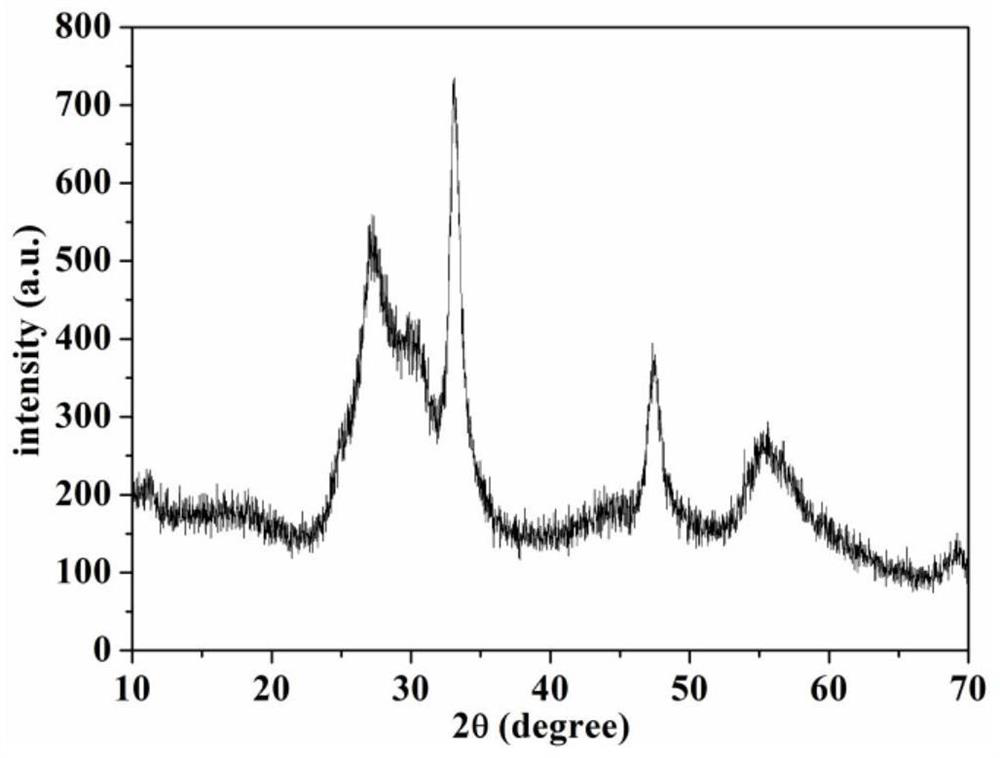Bi/beta-Bi2O3 heterojunction material as well as synthesis method and application thereof
A heterojunction, -bi2o3 technology, applied in the field of photocatalysis, can solve the problems of high price, not environmental protection and cheap, and achieve the effect of promoting separation, improving photocatalytic performance and short catalytic time
- Summary
- Abstract
- Description
- Claims
- Application Information
AI Technical Summary
Problems solved by technology
Method used
Image
Examples
Embodiment 1
[0036] Embodiment 1: the preparation of precursor
[0037] Dissolve 0.432g sodium gluconate in 30mL deionized water, then add 40mL PEG4000 aqueous solution (0.1mol / L), stir well, add 5ml Bi 3+ solution (0.2mol / L), then mixed with 5ml formamide, and continued to stir for 20 minutes to obtain a clear solution, then put it into a stainless steel autoclave with a 100mL polytetrafluoroethylene liner, seal it, and conduct a hydrothermal reaction at 120°C for 12 hours. After the reaction was completed, it was cooled to room temperature, and the obtained product was washed several times with deionized water and absolute ethanol, and finally vacuum-dried at 60° C. for 24 hours to obtain a precursor.
[0038] The morphology and crystal structure of the precursor samples were characterized by SEM and XRD. Such as figure 1 As shown, the precursor presents a bird's nest-like hierarchical structure composed of a large number of nanosheets with a thickness of about 20 nm, and a diameter of...
Embodiment 2
[0039] Example 2: Bi / β-Bi 2 o 3 Preparation of heterojunction materials
[0040] Put the precursor into a porcelain boat, place it in a tube furnace, and calcinate it at 280°C for 2 hours in a nitrogen atmosphere to obtain Bi / β-Bi 2 o 3 heterojunction samples.
[0041] Bi / β-Bi by SEM and XRD 2 o 3 The morphology and crystal structure of heterojunction samples were characterized, such as image 3 shown. Compared figure 1 ,From image 3 It can be seen that the product obtained after the sample was calcined at 280 °C for 2 hours still maintains the bird's nest micro-nano structure, but the outline of the nanosheet surface becomes clearer, which can be attributed to the better crystallization of the sample.
[0042] From Figure 4 It can be observed that the tetragonal β-Bi 2 o 3 (JCPDS No.27-0050) characteristic diffraction peaks, and can also find characteristic diffraction peaks attributed to rhombohedral phase Bi (JCPDS No.44-1246). And no peaks of other phases or...
Embodiment 3
[0043] Example 3: Bi / β-Bi 2 o 3 Photocatalytic performance of samples
[0044] Weigh 100mg photocatalyst and add 100mL RhB with a concentration of 10mg / L and 100mL levofloxacin hydrochloride solution with a concentration of 20mg / L respectively, place the prepared solution in a dark place and stir and disperse for 60min to reach the adsorption-desorption equilibrium. The photocatalytic reactions were carried out under visible light irradiation, respectively.
[0045] Figure 5 and Figure 6 Based on Bi / β-Bi 2 o 3 The sample is the UV-Vis absorption spectrum versus time curve of the photocatalytic degradation of RhB and levofloxacin hydrochloride respectively by the photocatalyst.
[0046] Depend on Figure 5 It can be seen that with the increase of visible light irradiation time, the intensity of the absorption peak of RhB at 553 nm gradually decreases, and after 105 min of irradiation, the maximum absorption peak of RhB solution almost completely disappears, indicating ...
PUM
 Login to View More
Login to View More Abstract
Description
Claims
Application Information
 Login to View More
Login to View More - R&D
- Intellectual Property
- Life Sciences
- Materials
- Tech Scout
- Unparalleled Data Quality
- Higher Quality Content
- 60% Fewer Hallucinations
Browse by: Latest US Patents, China's latest patents, Technical Efficacy Thesaurus, Application Domain, Technology Topic, Popular Technical Reports.
© 2025 PatSnap. All rights reserved.Legal|Privacy policy|Modern Slavery Act Transparency Statement|Sitemap|About US| Contact US: help@patsnap.com



